The Tiny House Movement
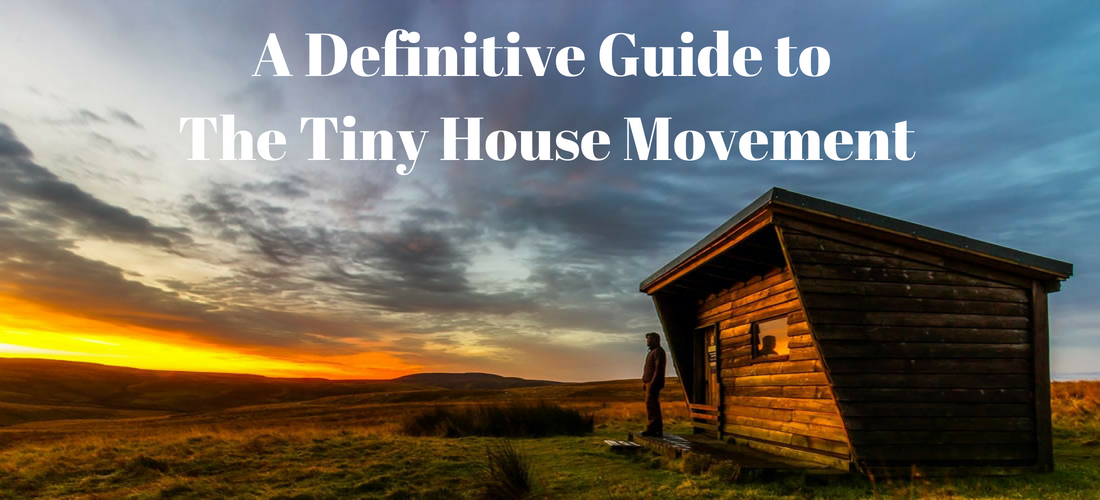
What is the tiny house movement? You see it on T.V. You read about it in magazines and online blogs like this one.
But what is the driving force behind the tiny house movement? How did it start? Why has it become so popular?
This article will take a long hard look at the tiny movement. I will help you understand its origin and I will enlighten you as to where it’s heading.
And I’m not just writing from a journalistic viewpoint. No. I’m actually a member of the tiny house community.
Who Should Read This and Why?
If you are considering building or buying or renting a tiny house, or if you are someone that just wants to embrace a minimalist lifestyle, or if you are just curious about all of us weirdos who are comfortable living in a walk-in closet, this article will leave no stone unturned when it comes to this housing phenomenon and I may pry your eyes open just a bit.
I’ll also share some of the challenges and hardships that go with the tiny house territory. This life isn’t for everyone and many people who move to a tiny house end up returning to conventional housing.
But ask yourself this: wouldn’t it be kind of cool to simplify your life? Wouldn’t be refreshing to dramatically decrease your living expenses? To eliminate the clutters of materialism? To rediscover homesteading even in a small way?
Let’s begin with the most basic question of all…
What is the Tiny House Movement?
The tiny house movement, as the name implies, is a social movement to promote living in small, affordable, energy efficient housing units.
These units come in many shapes, sizes and styles but they all take up far less space than the average American home.
But you must be wondering, why the heck would I give up my 3BR, 2BA house to live in a small box?
There are several reasons why a growing number of people are embracing the tiny house movement and all that it has to offer. Some may surprise you…
The economic downturn of 2008-2009 resulted in many people losing homes or finding themselves with underwater mortgages.
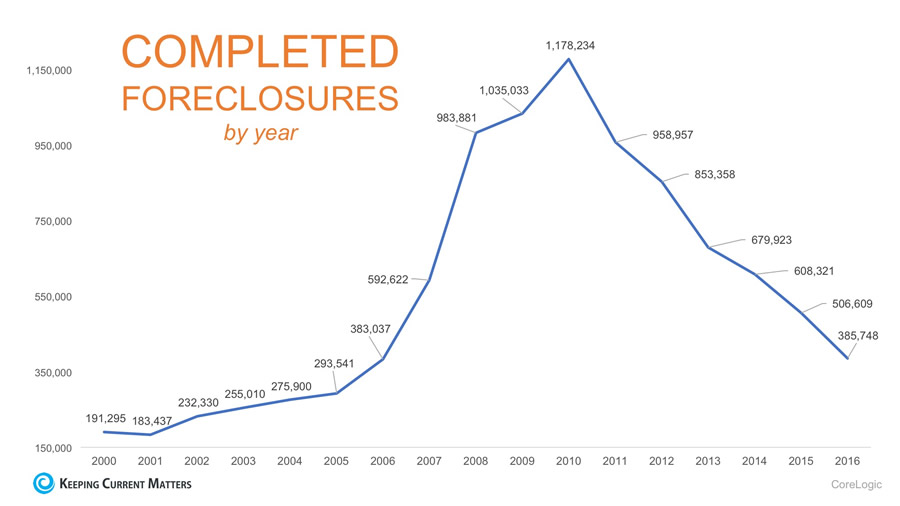
These individuals quickly learned that paying a high overhead for a home that could drastically drop in value with little or no warning put them in an extremely precarious financial position.
The fact that tiny homes cost little to build makes it easy for just about anyone to own his or her home; in fact, more than three-quarters of all individuals who live in a tiny home own their house outright and more than two-thirds of all tiny home homeowners have no mortgage.
No mortgage sounds pretty appealing, right?
Environmental concerns are another reason why many people are ditching large traditional homes in favor of smaller alternatives.
The construction of a tiny home requires far fewer raw materials than the construction of the average home. Furthermore, small homes use less energy and less water and create less waste than large ones.
Tiny homes also offer far more freedom than large ones. Here’s how…
Their low cost enables a person to work less than would have otherwise been possible, providing an individual with ample free time to pursue hobbies, travel and/or spend time with family and friends.
Even small home homeowners who do have a traditional 9 to 5 job no longer have to worry that an unexpected job loss will result in foreclosure and loss of a place to live.
Those are the primary reasons why people go tiny, but maybe we’re putting the cart before the horse. Why don’t we answer and even more fundamental question…
What the Heck are Tiny Houses Anyway?
Yeah, this may seem like an unnecessary question because simple logic deduces that if you ended up on this page, you probably already have an idea about tiny houses. But how much do you really know?
Tiny houses can be fixed or mobile… meaning anchored to a foundation or built on a trailer.
Mobile tiny house options include converted school buses, renovated RVs and trailers, houseboats and even adapted classic wagons re-designed to create a safe, cozy living space.
Fixed tiny house styles include renovated shipping containers, cob houses, yurts and A-frame cabins.
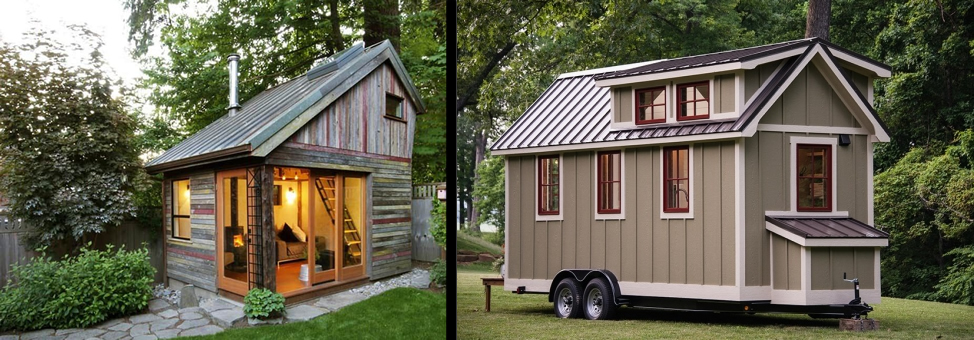
Shipping containers are among the most common option as they are widely available, durable, can be obtained in various sizes and are easy to renovate to suit one’s specific needs.
Tiny houses may be up to 400+ square feet in size; however, the average size for one of these units is just under 200 square feet.
Many people who live in tiny houses opt to build their own in order to cut down on construction costs. Recycled materials are often used to not only save money but also create an eco-friendly environment.
So why don’t we step back in time and take a peek on how this madness all started?
A Quick History of Tiny Houses and You Won’t Be Quizzed On It
The concept of living in a small living space has been around since the beginning of civilization.
Think about caves and tepees and wigwams and even covered wagons. (Your mom’s basement doesn’t count, sorry.)
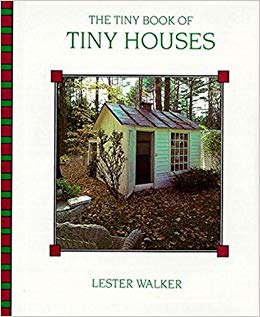 While America and other developed countries have moved away from the idea for many years, people began to show an interest in the concept of tiny homes in the 1980s when an architect by the name of Lester Walker published a book featuring photographs and pictures of various tiny home designs.
While America and other developed countries have moved away from the idea for many years, people began to show an interest in the concept of tiny homes in the 1980s when an architect by the name of Lester Walker published a book featuring photographs and pictures of various tiny home designs.
The idea gained steamed a decade after the book was published when Portland, Oregon, became the first city to allow people to build tiny homes without a special permit. (Of course Portland… what’d you think, Manhattan?)
The tiny house movement gained steam in the late 1990s and early 2000s. The Tumbleweed Tiny House company became the first business to sell mobile tiny homes.
The Small House Society was founded in 2002 to support research and development into tiny house construction.
Oprah Winfrey featured Small House Society founder Jay Shafer on her show in 2007, allowing viewers to get a peek into Mr. Shafer’s 96 square foot mobile home. Could you imagine Oprah living in a tiny house?
The show also provided valuable tips on how to maximize space when living in small quarters.
A few years later, a number of TV networks capitalized on the growing interest in the tiny house movement and offered their own TV shows dedicated to the topic.
The FYI channel aired the reality TV series Tiny House Nation in 2014; that same year, HGTV aired the show Tiny House Hunters featuring buyers considering the pros and cons of tiny house living before making a move to a small housing unit.
Take a guess how many TV shows have been produced about tiny houses?
Six, that I know of… Here’s the list:
- Tiny House, Big Living – HGTV Network
- Tiny House Nation – FYI Network
- Tiny House Hunters – HGTV Network
- Tiny House World – FYI Network
- Tiny House Hunting – FYI Network
- Tiny Luxury – HGTV Network
If I’m Giving Up Space There Better Be Some Benefits to Living in a Tiny House
There are many advantages and benefits of living in a tiny home. Here’s the deal…
Building a tiny home enables many people who don’t have unlimited finances to construct their own custom-made home without having to take out large loans.
It also provides suitable living space to many people who would be unable to own their own homes otherwise. This will surprise you…
It has been estimated that the average cost of building a tiny home is a mere $23,000 if the owner is willing to build it on his or her own.
By contrast, the average cost of buying a traditional home comes to well over $300,000 including home purchase interest rates. OMG!
A tiny house also offers a great deal of freedom for you if you enjoy traveling in a convenient, cost-efficient manner. How?
Mobile tiny homes are easy to move, providing you with the ability to visit other cities, states or even countries with relative ease. Key phrase here, relative ease.
As a tiny home homeowner you can move from your current city so much easier because you don’t have to sell a home and home furnishings before making a move.
Another type of freedom afforded to tiny home owners is the freedom to live a clutter-free life.
Because tiny homes have limited storage space, you can enjoy a downsized lifestyle with few belongings.
Given this fact, it is not surprising that, generally speaking, tiny home homeowners tend to have far more money in savings than regular homeowners. Want to know just how much money?
Try doing this exercise if you want to know how much lettuce you could save by living tiny…
Take a look at ALL of your expenses over the past 12 months and identify the things you bought that you would not have bought if you lived in a Tiny House. Add em up and there you go.
You’re welcome.
Possible Pitfalls of Tiny House Living – It’s Not for Everyone
While living in a tiny house has much to offer, it is not without its drawbacks. I speak from experience, which I’ll share some heartbreakingly, funny stories later…
Some aspiring tiny home homeowners find it difficult to locate land to build a permanent tiny house on. In fact, finding land is perhaps the biggest hurdle tiny peeps have to overcome. More on this later…
Those who live in mobile tiny houses may find it hard to park their tiny home wherever they like.
Zoning difficulties are perhaps one of the main drawbacks of moving to a tiny home.
While some cities and states have made it easy for you to build your own houses with relative ease, many other cities and states still have strict guidelines in place that make it difficult if not impossible for you to construct your safe, affordable tiny home.
This is such a concern, that zoning laws often dictate where you choose to live.
Naturally, many people who have initially shown an interest in the idea of living in a tiny house find that making the transition to tiny home living is far easier said than done. Here’s the bottom line…
The average American home is about 2,100 square feet, more than ten times larger than the average tiny home.
Moving from a large house to a small one entails an entire lifestyle change as one adapts to a small living space and learns how to make do with fewer belongings.
Nothing comes easy… which reminds me of a little story…
The Never Ending Road and the Gator from Hell
I promised a story or two about tiny house lessons learned the hard way. I’m a man of my word…
I woke up one morning, one October and decided, to hell with it, I’m going to live in a tiny house.
To make an impossibly long story short, a friend of mine just bought a 40 acre piece of recreational land in Central Florida, citrus and cattle country, with a large 10 acre lake and asked if I’d like to live on it and help him manage it…
He lived around 70 miles away from the property on the coast and I told him I didn’t even need to see it. Count me in.
So I left blustery Pittsburgh, PA the first week of a very cold January and headed south towards the promised land.
The idea was simple, I’d stay with him for a few weeks until I could find a travel trailer than move my carcass to the land and live happily ever after.
Man Plans. God Laughs.
The problem was there was no good way to get a travel trailer on the land as it did not have a road or driveway. Just grass, cows and cow poop. No problem, right?
“Let’s build a road!” we said to each other one night after too many glasses of wine.
“We’ll split the cost and it should be done in a couple of weeks.” We continued. “And hell, it shouldn’t cost more than $3,000 – $4,000.”
Three and a half months and $15,000 later we finally had a road and I was finally able to get my travel trailer parked on the property. The road, in all its glory, is pictured here as well as my humble abode.
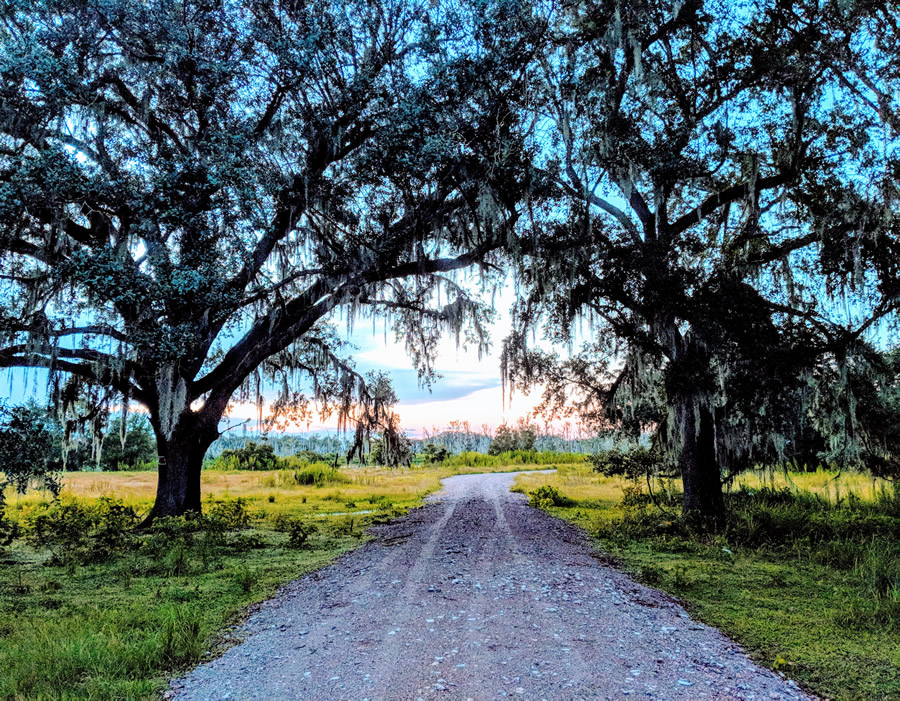
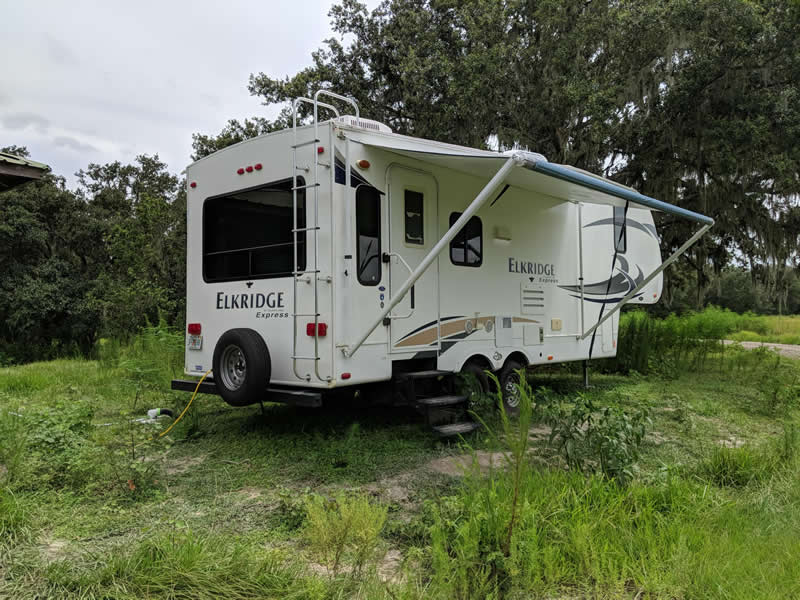
The delays were a collaboration of Murphy’s laws, bad contractors and a spiteful Mother Nature.
But I prevailed and I finally spent the first night in my tiny paradise and thought to myself, could it really get any better? And then I heard it…
Loud splashing from the lake just a few yards from my aluminum cocoon snapped me to attention. I looked out my window and shined my LED flashlight at the shore and saw the biggest alligator I’ve ever seen walking towards my trailer.
Alone on 40 acres with few neighbors except deer and wild boar -and apparently large reptiles -I decided that while I could cohabitate with furry woodland creatures and even swine, I would not be able to share my land with a creature that could quite literally eat me.
The next day, after 4 cups of coffee, an hour of internet research and just two phone calls, the FWC (Florida Wildlife Commission) put me in contact with a gator wrangler named Bob.
Bob agreed to meet at the property the very next day, which surprisingly he did. (Remember the road project.)
And after a mere two hours and a sphincter-tightening 15 minutes of pulling in a gator by hand on a line, the 7 foot gator who I christened Sneaky Pete, was in the back of Bob’s well-used pickup truck with his jaws taped shut. Here’s the gator and needless to say, he’s not happy.
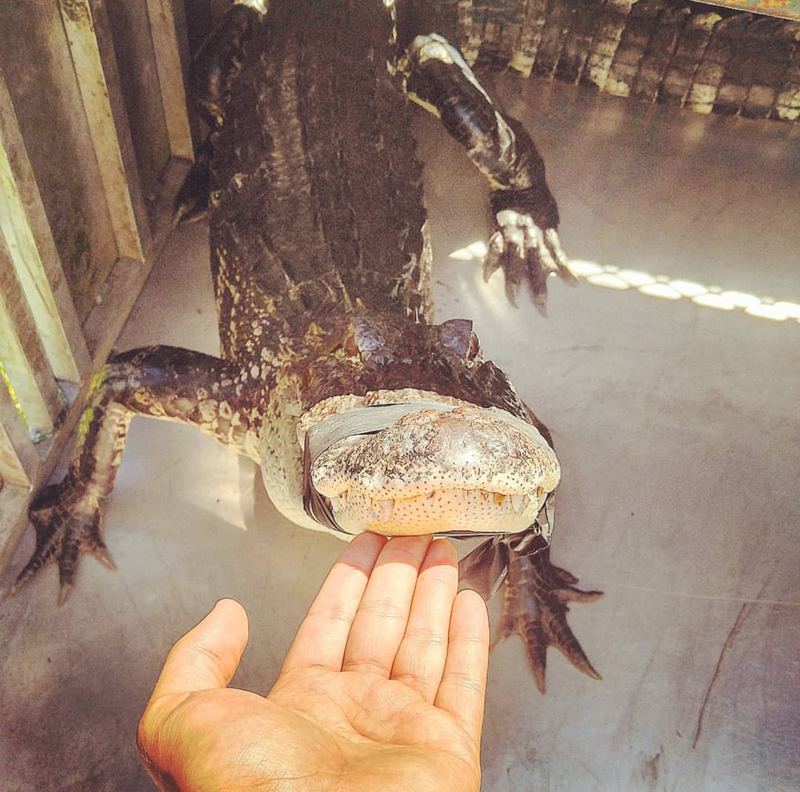
Mission accomplished.
So how do you know if you’ve got what it takes to be a tiny homer?
Is the Tiny House Movement Right for You?
The tiny house movement has much to offer people of all ages and walks of life. The benefits are real.
While it is a cost-efficient lifestyle, it’s not just one for those who have limited financial resources.
Tiny home owners are actually more likely to have a Master’s degree than traditional home owners and many people who are getting on in years opt to move into a tiny home rather than remaining or investing in a regular home.
And I bet you didn’t know this..
The average median salary of tiny home owners is actually more than that of regular homeowners. Interesting right?
While cost is one primary reason why many people choose to live in a small home, it is not the only reason or even the most important reason many homeowners choose to make such a drastic move.
So what’s more important than money you ask?
Tiny house living offers an unprecedented level of freedom and mobility.
Those who have adjusted to it enjoy having more free time, more savings and more flexibility than those living in a traditional home.
Tiny homes are comfortable, secure spaces (most don’t have gator problems) that can offer all the conveniences of modern living without the large debt that one must incur to buy a regular home.
They are also easier to clean and maintain than a regular home. In other words, you can fire your cleaning service.
Naturally, the tiny house movement doesn’t appeal to everyone.
Some people are simply unable to move into a small space while others choose not to because well, umm, they like big houses. Don’t judge.
Still others have tried it out and found it difficult to live a downsized lifestyle. Especially that family of 5 that moved to a 300 square-footer.
However, the tiny house movement is still gaining ground as a growing number of people realize that having a large, fancy, expensive home that can only be paid for by spending long hours at work, is not the ultimate American dream.
The ability to choose what you do with your own time, save money with ease, travel conveniently and in a cost efficient manner and know that you are making a positive difference to the environment by choosing and eco-friendly tiny home far outweigh all the disadvantages and inconveniences.
At least in my humble opinion.

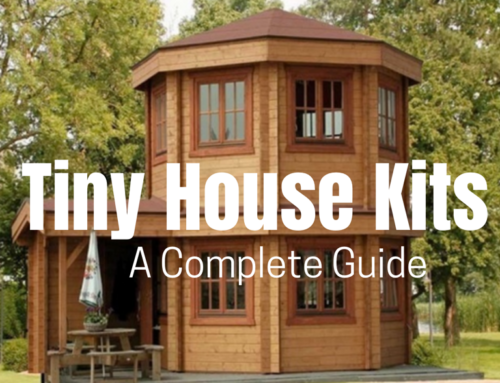
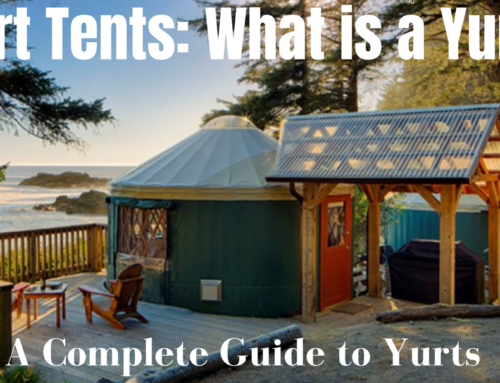

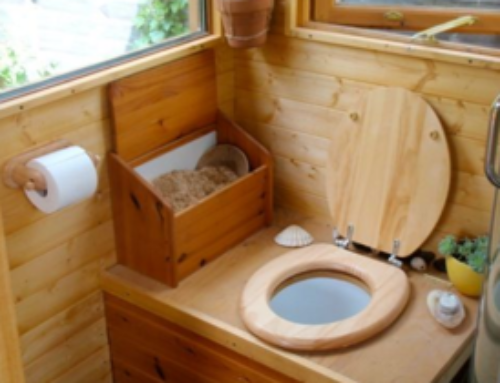
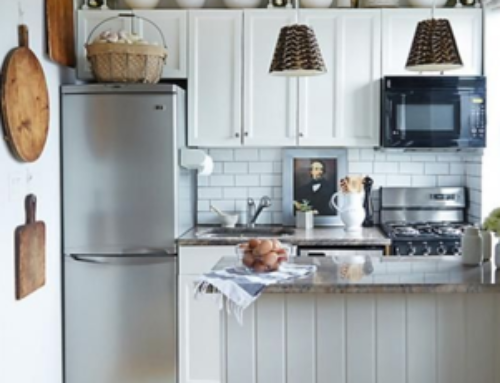
Leave A Comment